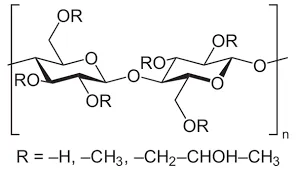
ਦਸੰ. . 10, 2024 23:14 Back to list
Understanding Hydroxypropyl Methyl Cellulose and Its Applications in Various Industries
Hydroxypropyl Methyl Cellulose A Versatile Polymer
Hydroxypropyl Methyl Cellulose (HPMC), characterized by its chemical composition and the presence of both hydroxypropyl and methyl groups, has garnered significant attention in various industries. With the CAS number 9004-65-3, HPMC is a modified cellulose derivative that plays a crucial role in many applications ranging from pharmaceuticals to construction materials.
Properties and Characteristics
HPMC is a white or off-white powder that is odorless and tasteless. It is known for its excellent water-retaining properties, unique viscosity characteristics, and its ability to form gels. The degree of substitution (DS) of HPMC affects its solubility and viscosity; the higher the level of substitution, the more soluble it becomes in water. This property makes HPMC an attractive choice for many applications, allowing for tailored viscosity and rheological properties based on specific needs.
Pharmaceutical Applications
In the pharmaceutical field, HPMC is widely used as a polymer in drug formulation. It serves as a binder in tablet formulations, ensuring that the active ingredients adhere together during compression. HPMC also acts as a thickening agent and a stabilizer in liquid formulations, which is essential for maintaining the consistency and stability of suspensions and emulsions.
Moreover, HPMC is increasingly being utilized in controlled-release drug delivery systems. Its ability to form a gel when in contact with water enables it to regulate the release of drugs over prolonged periods. This quality is particularly vital for medications that require steady plasma levels over extended durations.
Food Industry and Culinary Uses
In the food industry, HPMC is recognized for its emulsifying and stabilizing properties. It is often used in low-fat and gluten-free products to enhance texture and mouthfeel, giving consumers a more appealing eating experience. HPMC also acts as a thickener in sauces, dressings, and ice creams, improving their viscosity without altering the flavor.
Additionally, HPMC is used as a dietary fiber supplement due to its non-digestible nature. It provides bulk to food products, aids in digestion, and contributes to a feeling of fullness, making it a valuable component in weight management diets.
hydroxypropyl methyl cellulose cas no

Construction and Building Materials
HPMC has become an essential ingredient in the construction industry, particularly in the formulation of tile adhesives and drywall compounds. Its exceptional water-retaining ability allows for extended working time during the application of adhesives, ensuring proper adhesion and eliminating premature drying that can lead to structural failures.
In addition to tile adhesives, HPMC is also used in cement mortars and plasters, where it enhances the overall performance of the mixture. The addition of HPMC improves the viscosity and spreadability of the paste, ensuring a smoother finish and better workability.
Cosmetic and Personal Care Products
In the cosmetics sector, HPMC is frequently included in formulations for its thickening and stabilizing properties. It's found in a variety of products such as lotions, creams, and shampoos. By enhancing the texture of these products and providing a luxurious feel, HPMC plays a vital role in consumer satisfaction.
Moreover, HPMC is often employed as a film-forming agent in hair styling products, helping to maintain hairstyles while adding shine and smoothness. Its unique properties contribute significantly to the effectiveness and appeal of personal care items.
Environmental Considerations
As the world shifts towards sustainability, the demand for eco-friendly materials is on the rise. HPMC, being a cellulose derivative, is biodegradable and has a relatively low environmental impact compared to synthetic polymers. This quality aligns with the growing preference for sustainable and environmentally responsible products across various sectors.
Conclusion
Hydroxypropyl Methyl Cellulose is a multifaceted polymer that plays an integral role in a myriad of industries. Its versatility, coupled with its favorable properties, makes it an invaluable component in pharmaceuticals, food products, construction materials, and personal care formulations. As research and innovation continue to thrive, HPMC is likely to expand its footprint, further enhancing its applications and contributing to advances in technology and sustainability. With its approved status in various regulatory frameworks, HPMC is poised for continued growth and development in the coming years.
-
Unlocking the Benefits of HPMC Products: A Gateway to Versatile Applications
NewsAug.07,2025
-
Unleashing the Potential of HPMC Ashland: A Comprehensive Look
NewsAug.07,2025
-
Tile Bonding Cellulose: The Key to Superior Adhesion and Durability
NewsAug.07,2025
-
Hydroxypropyl Methylcellulose Powder: The Versatile Component in Modern Pharmaceuticals
NewsAug.07,2025
-
Hydroxyethyl Cellulose: The Versatile Solution for Various Industries
NewsAug.07,2025
-
Hydroxyethyl Cellulose (HEC): The Versatile Polymer for Various Applications
NewsAug.07,2025







